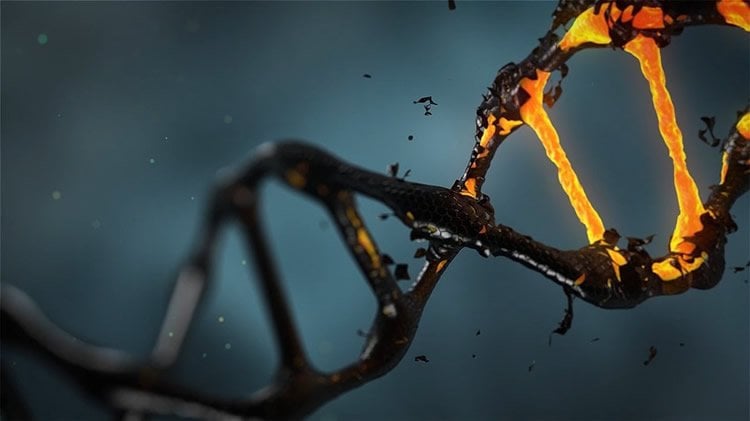Summary: A new study has identified a number of cancer associated genes as being linked to ASD. Researchers suggest certain cancer treatments that target these genes may also be helpful in treating autism disorders.
Source: Frontiers.
The identification of genes related to autism spectrum disorder (ASD) could help to better understand the disorder and develop new treatments. While scientists have found many genetic differences in different people with ASD, these often show little overlap and don’t appear to be related. Using a new technique that accounts for how genes interact, Italian researchers have identified new networks of related genes that may be involved in ASD – including genes that are related to cancer.
Autism spectrum disorder encompasses a range of neurodevelopmental disorders, and includes conditions like autism and Asperger’s syndrome. ASD symptoms vary significantly, but typically start within the first three years of life and include repetitive behaviors, and difficulty communicating and socializing.
Autism spectrum disorder has a significant genetic component, and scientists have found thousands of genetic differences between some people with ASD and those without. Researchers suspect that many of these genetic anomalies can predispose people to the disorder, or directly contribute to it.
However, ASD is complex, and researchers have only begun to unravel its genetic basis. One problem is that many studies have found completely different genetic anomalies in different people with ASD, which show little overlap and don’t appear to be related.
This makes it difficult to find common hallmarks that could provide better clues to understanding and treating the disorder. While this genetic variability demonstrates that ASD is incredibly complex, a new technique could help to cast more light on the situation.
When a cell in your body expresses a gene, it produces a specific protein. These proteins interact to form complex signaling pathways that can have wide-reaching effects. Different genes could affect the same pathway, meaning that the different genetic anomalies found in people with ASD could potentially all be affecting similar pathways.
By accounting for how genes interact, rather than just looking at individual genes, scientists might potentially spot biological hallmarks of ASD they might otherwise miss. In a study recently published in Frontiers in Genetics, researchers in Italy used a new computational technique to do just that.
Searching public databases, the team investigated genes that previous studies have associated with ASD. They used another database listing interactions between different proteins, to narrow down the list of genes and account for interactions between them.
Using a computational technique called network diffusion, the team identified networks of genes that are interrelated through their connection to the ASD genes in the databases. They also investigated if the genes were involved in any known signaling pathways.

So, what do these genes do? Some of the ASD genes in the networks are involved in brain function and how neurons develop and transmit information. Others are involved in conditions that tend to occur alongside ASD, such as psychiatric disorders and epilepsy, and interestingly, some of the genes are also involved in cancer.
The team also identified genes that had not been previously linked to ASD, but are heavily involved in numerous protein interactions and signaling pathways. Using their data, the team constructed complex pathway maps that could provide clues about ASD and potential treatments.
For example, many of the genes in the new networks are related to cancer, suggesting that certain cancer treatments that target these genes might also be useful to treat ASD. The team’s computational technique can also be used to learn about other conditions.
“The computational method we have proposed can be applied to other data-sets to predict new genes involved in other conditions,” says Alessandra Mezzelani, a researcher involved in the study. “We hope that global gene databases will continue to grow, allowing scientist to share and reuse these types of data, and we will update our model as more ASD risk genes are discovered.” says Ettore Mosca, who was also involved.
Funding: The study was funded by the Italian Ministry of Education and Research, InterOmics Flagship, PRIN, Lombardy region FRRB, European MIMOmics.
Source: Emma Duncan – Frontiers
Image Source: NeuroscienceNews.com image is in the public domain.
Original Research: Full open access research for “Network Diffusion-Based Prioritization of Autism Risk Genes Identifies Significantly Connected Gene Modules” by Ettore Mosca, Matteo Bersanelli, Matteo Gnocchi, Marco Moscatelli, Gastone Castellani, Luciano Milanesi and Alessandra Mezzelani in Frontiers in Genetics. Published online September 25 2017 doi:10.3389/fgene.2017.00129
[cbtabs][cbtab title=”MLA”]Frontiers “Newly Revealed Autism Related Genes Include Some Implicated in Cancer.” NeuroscienceNews. NeuroscienceNews, 25 September 2017.
<https://neurosciencenews.com/autism-cancer-genetics-7574/>.[/cbtab][cbtab title=”APA”]Frontiers (2017, September 25). Newly Revealed Autism Related Genes Include Some Implicated in Cancer. NeuroscienceNews. Retrieved September 25, 2017 from https://neurosciencenews.com/autism-cancer-genetics-7574/[/cbtab][cbtab title=”Chicago”]Frontiers “Newly Revealed Autism Related Genes Include Some Implicated in Cancer.” https://neurosciencenews.com/autism-cancer-genetics-7574/ (accessed September 25, 2017).[/cbtab][/cbtabs]
Abstract
Network Diffusion-Based Prioritization of Autism Risk Genes Identifies Significantly Connected Gene Modules
Autism spectrum disorder (ASD) is marked by a strong genetic heterogeneity, which is underlined by the low overlap between ASD risk gene lists proposed in different studies. In this context, molecular networks can be used to analyze the results of several genome-wide studies in order to underline those network regions harboring genetic variations associated with ASD, the so-called “disease modules.” In this work, we used a recent network diffusion-based approach to jointly analyze multiple ASD risk gene lists. We defined genome-scale prioritizations of human genes in relation to ASD genes from multiple studies, found significantly connected gene modules associated with ASD and predicted genes functionally related to ASD risk genes. Most of them play a role in synapsis and neuronal development and function; many are related to syndromes that can be in comorbidity with ASD and the remaining are involved in epigenetics, cell cycle, cell adhesion and cancer.
“Network Diffusion-Based Prioritization of Autism Risk Genes Identifies Significantly Connected Gene Modules” by Ettore Mosca, Matteo Bersanelli, Matteo Gnocchi, Marco Moscatelli, Gastone Castellani, Luciano Milanesi and Alessandra Mezzelani in Frontiers in Genetics. Published online September 25 2017 doi:10.3389/fgene.2017.00129






